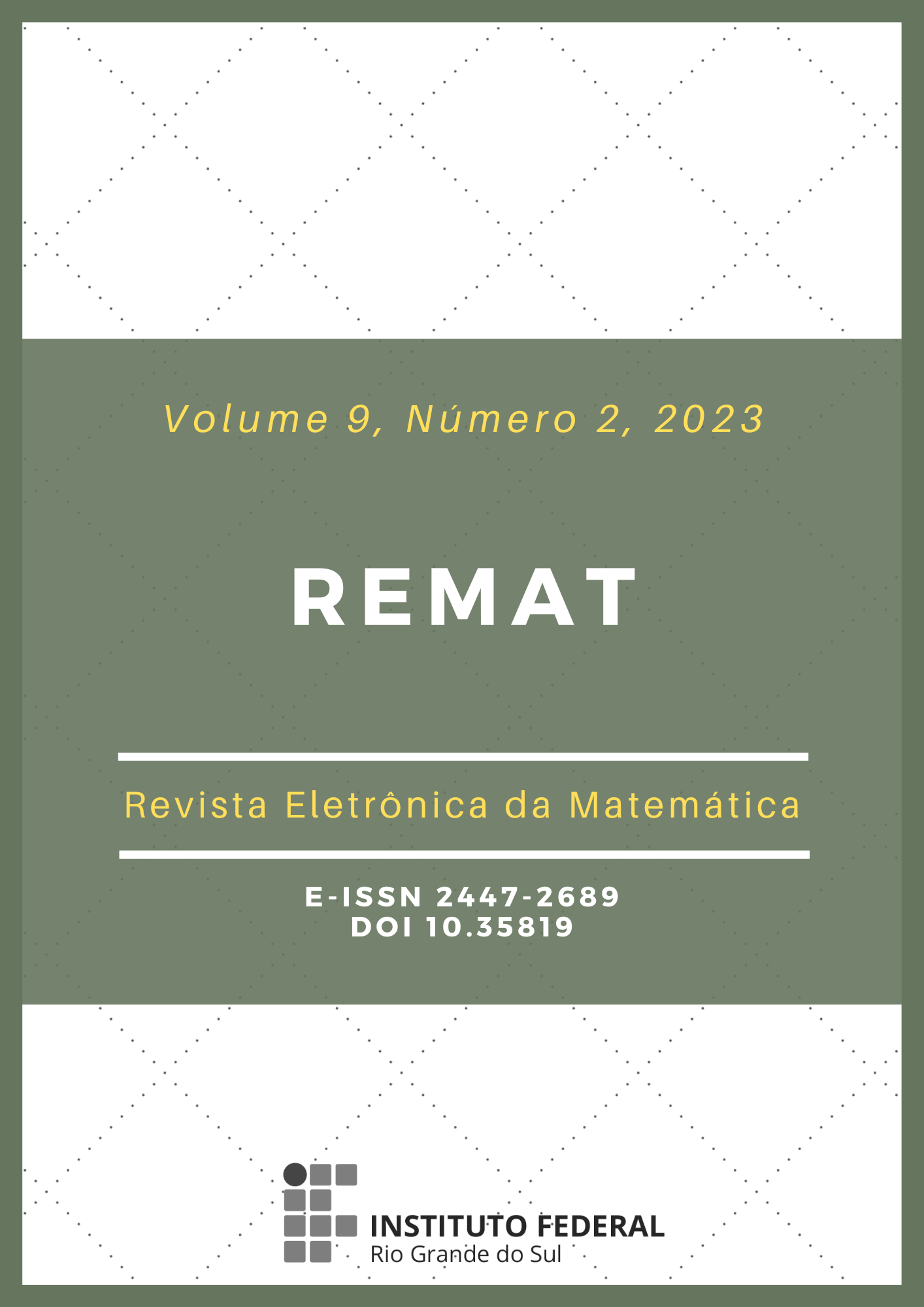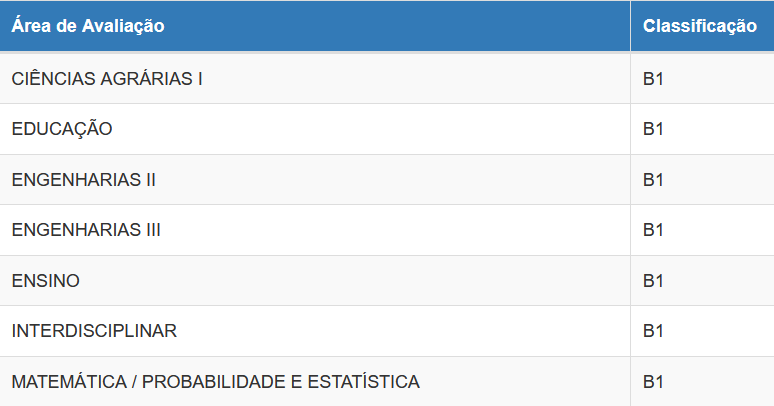Teaching of Fractal Geometry in Basic Education: a systematic review
DOI:
https://doi.org/10.35819/remat2023v9i2id6397Keywords:
Math Education, Math Teaching, Mathematics Research, Fractal GeometryAbstract
Fractal Geometry is an area of Mathematics that studies the properties of complex figures that have great aesthetic appeal and, therefore, have the potential to arouse the interest of students. Aiming to obtain an overview of research on the teaching of Mathematics involving Fractal Geometry, within the scope of Basic Education, a systematic review of the literature on the subject is presented here. The bases used were the CAPES Periodicals Portal, Google Scholar and the Brazilian Digital Library of Theses and Dissertations (BDTD/IBICT), within the range from 2018 to 2021, obtaining a preliminary result of 862 studies on the subject, of which 58 were considered relevant. According to the inclusion criteria, allowing theses, dissertations and articles within the scope of Basic Education, 13 studies were obtained that were relevant to the objectives of the review. For the subsequent analysis, the guiding question was established: “How is the teaching of Fractal Geometry in Elementary School II, High School and Youth and Adult Education?”, being proposed 8 complementary questions that allowed consolidating a series of information. Some promising research and application gaps for Mathematics Education were identified, with the possibility of generating significant knowledge from the use and application of Fractal Geometry, effectively in the classroom.
Downloads
References
ABLE, S. L. R. A geometria fractal no processo de ensino-aprendizagem-avaliação de probabilidade geométrica. Orientador: Adilson da Silveira. 108 f. 2021. Dissertação (Mestrado em Programa de Mestrado Profissional em Matemática em Rede Nacional) – Universidade Tecnológica Federal do Paraná, Pato Branco, 2021. Disponível em: http://repositorio.utfpr.edu.br/jspui/handle/1/27029. Acesso em: 10 jul. 2022.
AGUILAR, V. L. de; SILVA, R. C. da; ROMANINI, E. Geometria Fractal: abordando conceitos a partir de construções com o software GeoGebra. Revista Ensin@ UFMS, v. 1, n. 4, p. 52-72, 2019. Disponível em: https://periodicos.ufms.br/index.php/anacptl/article/view/10449. Acesso em: 10 jul. 2022.
BARBOSA, R. M. Descobrindo a Geometria Fractal para a Sala de Aula. Belo Horizonte: Autêntica Editora, 2005.
ELEUTÉRIO, A. P. O espaço de Hausdorff e a dimensão fractal: estudo e abordagens no Ensino Fundamental. Orientadora: Ana Paula Tremura Galves. 105 f. 2021. Dissertação (Mestrado Profissional em Matemática em Rede Nacional) – Universidade Federal de Uberlândia, Uberlândia, 2021. DOI: https://doi.org/10.14393/ufu.di.2021.599.
FALCONER, K. Fractal Geometry: Mathematical Foundations and Applications. 2. ed. West Sussex-England: Wiley, 2003.
GALVÃO, M. C. B.; RICARTE, I. L. M. Revisão Sistemática da Literatura: Conceituação, Produção e Publicação. Revista Logeion: Filosofia da Informação, v. 6, n. 1, p. 57-73, 2019. DOI: https://doi.org/10.21728/logeion.2019v6n1.p57-73.
GIL-GARCÍA, J.; GIMENO-DOMÍNGUEZ, M.; MURILLO-FERROLL, N. L. The arterial pattern and fractal dimension of the dog kidney. Histology and Histopathology, v. 7, n. 4, p. 563-574, 1992. Disponível em: https://pubmed.ncbi.nlm.nih.gov/1457978. Acesso em: 8 set. 2022.
JIANG, B.; BRANDT, S. A. A Fractal Perspective on Scale in Geography. International Journal of Geo-Information, v. 5, n. 95, p. 1-12, 2016. DOI: https://doi.org/10.3390/ijgi5060095.
LEIVAS, J. C. P.; BETTIN, A. D. H. Teorema de Pitágoras e o Fractal Árvore Pitagórica: Um Experimento no Ensino Fundamental. Brazilian Journal of Education, Technology and Society, v. 11, n. 3, p. 444-457, 2018. Disponível em: https://brajets.com/v3/index.php/brajets/article/view/462. Acesso em: 20 set. 2023.
LISBOA, M. C. Uma proposta de abordagem da geometria fractal na educação básica. Orientador: Alcione Marques Fernandes. 2019. 59 f. Dissertação (Mestrado Profissional em Matemática) – Programa de Pós-Graduação em Matemática, Universidade Federal do Tocantins, Arraias, 2019. Disponível em: https://repositorio.uft.edu.br/handle/11612/2039. Acesso em: 10 jul. 2022.
MANDELBROT, B. The Fractal Geometry of Nature. Brattelboro, Vermont: Echo Point Books & Media LLC, 1983.
MURARI, C. Espelhos, caleidoscópios, simetrias, jogos e softwares educacionais no ensino e aprendizagem de Geometria. In: BICUDO, M. A. V.; BORBA, M. C. (org.). Educação Matemática: Pesquisa em movimento. 4. ed. São Paulo: Cortez, 2012. p. 216-231.
OBERGUGGENBERGER, M.; OSTERMANN, A. Analysis for Computer Scientists. Foundations, Methods, and Algorithms. 2. ed. Londres: Springer-Verlag, 2018.
OLIVEIRA, M. A. T. de. A geometria do conjunto de Cantor, do tapete de Sierpinski e da esponja de Menger. Orientador: Marcelo Ferreira de Melo. 2020. 85 f. Dissertação (Mestrado Profissional em Matemática em Rede Nacional) – Centro de Ciências, Departamento de Matemática, Universidade Federal do Ceará, Fortaleza, 2020. Disponível em: https://repositorio.ufc.br/handle/riufc/57647. Acesso em: 10 jul. 2022.
PAPERT, S. A Máquina das Crianças: repensando a escola na era da informática. Porto Alegre: Artmed, 2008.
PEREIRA, T.; BORGES, F. A. A Geometria dos Fractais no Ensino de Matemática: Uma revisão bibliográfica categorizada das pesquisas brasileiras dos últimos dez anos. Acta Scientiae. v. 19, n. 4, p. 563-581, jul/ago. 2017. Disponível em: http://www.periodicos.ulbra.br/index.php/acta/article/viewFile/2424/2525. Acesso em: 4 set. 2022.
RASBAND, S. N. Chaotic Dynamics of Nonlinear Systems. Mineola, New York: Dover Publications Inc., 2015.
Rezende, V.; MORAN, M.; MÁRTIRES, T. M.; PAIXÃO, F. C. O Fractal Árvore Pitagórica e Diferentes Representações: uma Investigação com Alunos do Ensino Médio. Jornal Internacional de Estudos em Educação Matemática, v. 11, n. 2, p. 160-171, 2018. Disponível em: https://jieem.pgsscogna.com.br/jieem/article/view/4616. Acesso em: 3 jul. 2022.
ROONEY, A. A História da Matemática. São Paulo: M. Books do Brasil, 2012.
SAMPAIO, R. F.; MANCINI, M. C. Estudos de revisão sistemática: um guia para síntese criteriosa da evidência científica. Revista Brasileira de Fisioterapia, São Carlos, v. 11, n. 1, p. 83-89, jan./fev. 2007. DOI: https://doi.org/10.1590/S1413-35552007000100013.
SARI, D.; RAHARJO, J.; NOVAMIZANTI, L. Cholesterol Level Detection Through Eye Image Using Fractal and Decision Tree. IOP Conference Series: Materials Science and Engineering, n. 982, 2020. DOI: https://doi.org/10.1088/1757-899X/982/1/012010.
SILVA, M. V. O. L. da. Geometria fractal e atividades para o ensino de matemática: degraus fractais e esponja de Menger. Orientadora: Simone Maria de Moraes. 2020. 73 f. Dissertação (Mestrado Profissional em Matemática em Rede Nacional) – Universidade Federal da Bahia, Bahia, 2020. Disponível em: https://repositorio.ufba.br/handle/ri/33387. Acesso em: 10 jul. 2022.
SOUZA, S. P. de. A geometria fractal para o ensino de diversos tópicos de matemática no Ensino Médio. Orientadora: Ariane Luzia dos Santos. 2022. 85 f. Dissertação (Mestrado Profissional em Matemática) – Universidade Estadual Paulista, 2022. Disponível em: http://hdl.handle.net/11449/216640. Acesso em: 10 jul. 2022.
SULEIMAN, A. R. Fractais: Possibilidades Pedagógicas na Escola Básica. Ensino da Matemática em Debate, v. 6, n. 1, p. 61-83, 2019. DOI: https://doi.org/10.23925/2358-4122.2019v10i1p53-71.
TAYLOR, T. D. Golden Fractal Trees. In: SARHANGI, R.; BARRALO, J. Bridges Donostia: Mathematics, Music, Art, Architecture, Culture. Londres: Tarquin Publications, p. 181-188, 2007. Disponível em: https://archive.bridgesmathart.org/2007/bridges2007-181.html. Acesso em: 30 set. 2022.
TEIA, L. Anatomy of the Pythagoras’ tree. Australian Senior Mathematics Journal, v. 30, n. 2, p. 38-47, 2016. Disponível em: https://files.eric.ed.gov/fulltext/EJ1121416.pdf. Acesso em: 12 out. 2022.
VALMORBIDA, J. M. Uma proposta de atividades para o estudo de progressões geométricas utilizando fractais e o software GeoGebra. Orientadora: Rosane Rossato Binotto. 2018. 124 f. Dissertação (Mestrado Profissional em Matemática) – Universidade Federal da Fronteira Sul, Chapecó, 2018. Disponível em: https://rd.uffs.edu.br/handle/prefix/2179. Acesso em: 10 jul. 2022.
VIEIRA, D. C. O uso da geometria fractal como ferramenta no ensino de progressões geométricas e logaritmos. Orientador: José Antonio Salvador. 2019. 90 f. Dissertação (Mestrado em Ensino de Ciências Exatas) – Universidade Federal de São Carlos, São Carlos, 2019. Disponível em: https://repositorio.ufscar.br/handle/ufscar/11399. Acesso em: 10 jul. 2022.
Wanderley, L. R.; SOUTO, R. A.; DIDIER, M. A. C.; TANAKA, T. Y. Construção de Fractais Geométricos com o GeoGebra: Árvores Bifurcadas e o Triângulo de Sierpinski. Revista do Professor de Matemática, Rio de Janeiro, n. 104, 2021. Disponível em: https://rpm.org.br/rpm/img/conteudo/files/RPM%20-%20Fractais%20e%20GeoGebra%20-(1).pdf. Acesso em: 10 jul. 2022.
Downloads
Published
How to Cite
Issue
Section
License
Copyright (c) 2023 REMAT: Revista Eletrônica da Matemática

This work is licensed under a Creative Commons Attribution 4.0 International License.
REMAT retains the copyright of published articles, having the right to first publication of the work, mention of first publication in the journal in other published media and distribution of parts or of the work as a whole in order to promote the magazine.
This is an open access journal, which means that all content is available free of charge, at no cost to the user or his institution. Users are permitted to read, download, copy, distribute, print, search or link the full texts of the articles, or use them for any other legal purpose, without requesting prior permission from the magazine or the author. This statement is in accordance with the BOAI definition of open access.

































